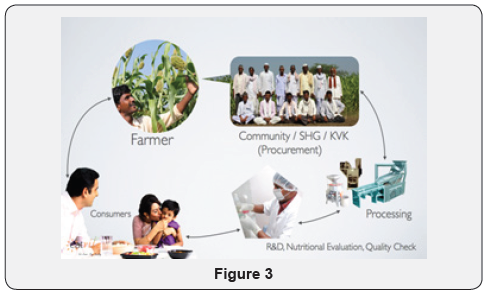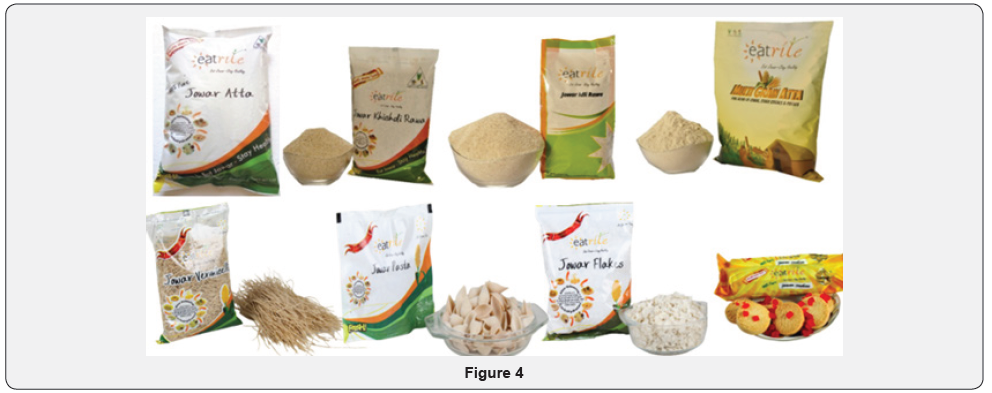Value Addition to Millets - Juniper publishers
Journal of Trends in Technical and Scientific Research
Opinion
Indian Institute of Millets Research (IIMR) has
pioneered in diversification of processing technologies in millet in
order to provide wide options to consumers, otherwise prior to IIMR
initiative due to absence of the convenient technologies in millets led
to decline in their consumption. Developed millets value added Ready to
Cook/Ready to Eat products, now value added technologies are made
available for wider consumption to meet the consumer requirements
(healthy and tasty).
Description of Technology
Millets are neither ready to eat nor ready to cook
grains and need some kind of processing invariably for human
consumption. Most commonly followed conventional processing
methodologies are milling including decortication and size gradation,
popping, malting, and fermentation. In the recent years the contemporary
food processing technologies such as extrusion cooking, cold extrusion
(vermicelli/ pasta/noodles), baking, flaking and, puffing are applied
for millets (Figure 1).

Primary processing
It is the processing to clean the grain through grading
(depend on size of the grain), de-stoning (removal of stones)
and de-hulling (polishing). The bulk operations of these
processes can be done mechanically. Primary processing of the
grain is removal of waste, stones and glumes from the grain
that are necessary as it improves the storage of the grain.
Secondary processing
It involves use of the primary processed raw material in
to different ready to cook sorghum products such as flour and
semolina or suji (fine and medium), sorghum based multigrain
flour, extruded products (vermicelli and pasta) and parboiled
sorghum and ready to eat (biscuits, flakes, pops and multigrain
roti) (Figure 2) .

Interventions
a. Standardized primary processing of millets
b. Enhanced shelf life
c. Identified cultivars suitable for specific products
d. Nutrition profiling done
e. Established nutritional superiority over existing rice/
wheat based products
f. Machines are developed and standardized to processing
millets
g. Backward integrator model established in collaboration
with ITC (ABD)
h. Farm gate processing helped in value addition to
farmers
Commercialization
IIMR has developed 40 technologies of which 22 millet
products are commercialized under the brand of “eatrite”
solely to increase the consumption of millet in the country.
Processing technologies were licensed by IIMR to 40 private
companies some of them have established millet processing
units in different states Telangana (8), Andhra Pradesh,
Maharashtra (2), Tamilnadu (2), Karnataka (1), and New Delhi
(3) to manufacture and promote sorghum and millet value
added products to reach millet products to consumers. Multi
National Company M/s Britannia Industries Ltd. signed MoU
with IIMR to work jointly on R&D of millet bakery products
(biscuits) to include millets in nutri-choice (Figure 3&4).


Impact
Value addition to the millets impact on different aspects
primarily it creates demand and usage of millets in the
consumer’s daily diet in present lifestyle. Millets have good
health benefits to prevent diabetes, cardiovascular disease,
blood pressure, cancer etc. entrepreneurs come forward to
start the millet processing units for this they required raw
material so ultimately its impact on farmers to cultivate millets
to meet the demand for processing and consumption of millets.
On technological intervention has been successful in creating
options for consumers in millets. This has led to impact both
consumers whoever suffering from life style diseases as
healthy choice but also to enhance the farmer’s income.
To Know More About Trends in Technical and ScientificResearch click on: https://juniperpublishers.com/ttsr/index.php
To Know More About Open Access Journals Please click on:




Comments
Post a Comment